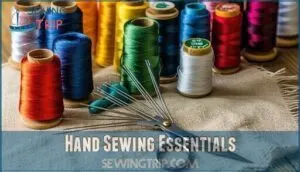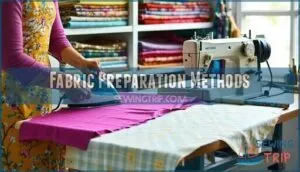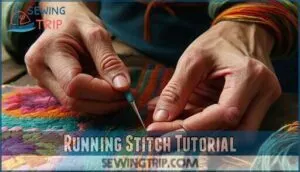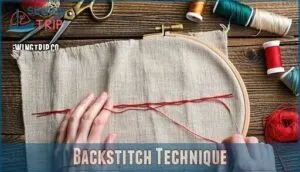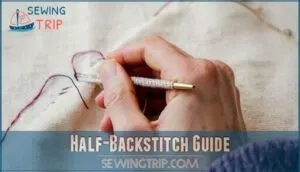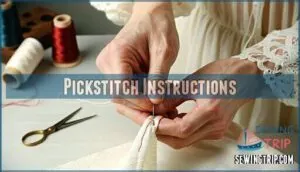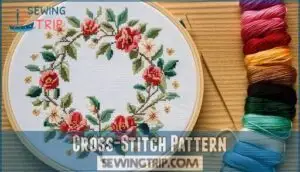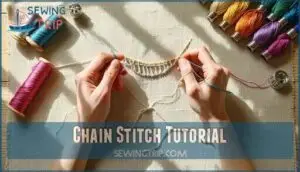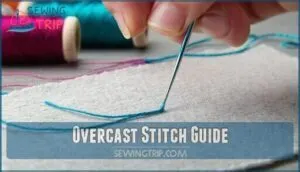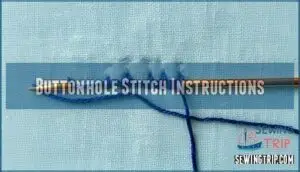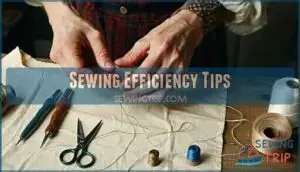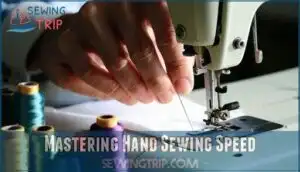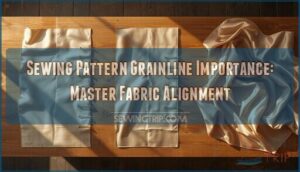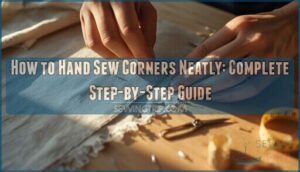This site is supported by our readers. We may earn a commission, at no cost to you, if you purchase through links.
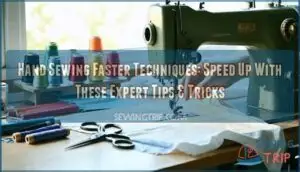
Use a sharp needle matched to your fabric and keep your thread length manageable—about 18 inches avoids annoying tangles.
Practice consistent, small stitches, like a running or backstitch, to save time while keeping things neat.
Prep your fabric by ironing and cutting clean edges—trust me, it’s worth it.
Keep tools like scissors, pins, and thread organized for a smoother workflow.
And here’s the trick: find a rhythm.
Hand sewing is like music; when you get into the groove, everything clicks.
Ready to stitch smarter, not harder?
Hand sewing requires patience and practice to achieve professional results.
Table Of Contents
Key Takeaways
- Use sharp needles matched to your fabric and keep your thread short—no more than 18 inches—to prevent tangling.
- Start with basic stitches like the running stitch or backstitch for speed and durability, practicing consistent lengths for clean results.
- Prep your fabric by ironing, pre-washing, and cutting clean edges to avoid fraying and ensure smoother stitching.
- Organize your tools and workspace, and batch tasks like pinning or pressing to streamline your sewing process.
Hand Sewing Essentials
If you want to sew faster, it all starts with the right tools. From picking the perfect needle to choosing tangle-free thread, having the essentials makes all the difference.
Needle Selection Tips
Choosing the right sewing needle is like picking the perfect tool for a job—it makes everything smoother.
The perfect needle transforms your sewing experience, making every stitch smoother, faster, and frustration-free.
Match needle size and point type to your fabric for better results. Specialty needles, like sharps or milliners, suit specific hand sewing techniques.
Consider exploring different types of sewing needles for specialized tasks. Stick with trusted needle brands for quality.
A well-chosen needle means hand sewing faster and frustration-free!
Thread Choice Guide
Picking the right sewing thread is like choosing the right teammate—it makes all the difference.
Match thread fiber types to your fabric, like cotton for natural fibers or polyester for synthetics.
Use a thread weight guide for durability, and follow color matching tips for polished results.
Specialty threads add flair, but good thread storage keeps your hand sewing techniques fast and frustration-free.
Consider exploring different sewing thread options for specialized projects.
Safety Pins Usage
Matching threads to fabric is smart, but don’t overlook safety pins—they’re tiny heroes in hand sewing.
Use them for elastic insertion, fabric alignment, or seam holding.
Need temporary marking? A pin works in a pinch! They’re also lifesavers for quick fixes, like holding layers steady.
Add this sewing hack to your toolkit for smoother, faster projects.
Fabric Preparation Methods
Getting your fabric ready is the first step to faster, frustration-free sewing. A little prep work—like ironing and pre-washing—saves time and headaches later.
Ironing Techniques
Mastering your ironing technique boosts sewing speed effortlessly.
Smart ironing saves you headaches later.
Always iron fabrics before sewing to prevent awkward wrinkles messing up your work.
- Use the right ironing temperature for your fabric.
- Steam tricky spots for extra smoothness.
- Layer a pressing cloth to protect delicate fabrics.
- Keep your iron maintained to avoid surprises.
- Iron in logical order to reduce rework.
The key to efficient sewing is smart ironing and maintaining your iron to prevent any awkward wrinkles.
Cutting Fabric Edges
After ironing, focus on cutting fabric edges cleanly for faster sewing.
Use pinking shears to prevent fraying or bias cuts for stretchy, durable edges.
When working with layered fabrics, trim evenly to avoid bulk.
A quick stitch guide starts with neat edges—trust us, messy cuts slow you down!
Here’s a handy table for edge finishing:
| Tool | Purpose | Benefit |
|---|---|---|
| Pinking Shears | Preventing Fraying | Clean, zigzagged edges |
| Rotary Cutter | Bias Cuts | Smooth, precise lines |
| Fabric Scissors | Layered Fabrics | Cuts through multiple layers easily |
The key to efficient sewing is clean edges and the right tools for the job, making it easier to achieve professional results with less effort.
Pre-Washing Fabric
If you skip prewashing fabric, expect surprises like shrinkage, color bleeding, or texture changes later.
Prewashing fabric saves you from shrinking surprises and keeps colors vibrant—prep now to prevent regrets later.
Prewashing isn’t glamorous, but it’s key for shrinkage control and fabric softening.
Toss your fabric in the wash, dry it, and iron out wrinkles to prevent future headaches.
This simple step guarantees your sewing techniques shine without unexpected hiccups mid-project, ensuring a successful outcome with proper fabric softening.
Pressing Finished Projects
When you’re done sewing, pressing your project can work wonders for seam appearance.
Use the right iron settings based on fabric type, and rely on pressing tools like a tailor’s ham for tricky areas.
Press, don’t iron—you’ll avoid stretching fabrics.
This sewing tip gives your hand sewing a professional finish, proving even small touches amplify sewing techniques for beginners.
Starching the fabric beforehand improves cutting accuracy, which is a crucial step for achieving a perfect cut.
Basic Hand Sewing Stitches
Learning basic hand sewing stitches is like discovering a secret toolkit for crafting and repairs. With a few simple techniques, you’ll stitch faster and more confidently in no time!
Running Stitch Tutorial
The running stitch is your go-to for sewing faster by hand. It’s simple, versatile, and perfect for straight seams or quick fixes.
Here’s how to master it:
- Knot your thread’s end.
- Push the needle through the fabric type.
- Keep stitch length consistent.
- Adjust thread tension for smooth results.
- Practice curve stitching for tricky edges.
For decorative work, consider using embroidery thread options to achieve a smooth results.
Backstitch Technique
The backstitch is your go-to for securing seams with strength and precision.
Unlike the running stitch, it’s all about overlapping stitches, creating a dense, durable line. Keep thread tension steady for clean results.
Use these fast sewing methods to stitch faster by hand. Check out the table below for quick tips:
| Tip | Why It Works | Shortcut |
|---|---|---|
| Overlap stitches | Adds durability | Supports seam strength |
| Use sharp needles | Suits fabric types | Speeds up sewing |
| Maintain tension | Prevents puckering | Improves stitch density |
Half-Backstitch Guide
The half-backstitch is like the backstitch’s speedy sibling.
It alternates stitch and space, making it great for quick seams or decorative lines.
This rapid stitch technique balances strength and speed, perfect for lightweight fabrics.
Avoid common errors like uneven spacing by practicing on scraps.
For speed improvement, keep tension steady and use sharp needles for smoother fabric application.
Pickstitch Instructions
The pickstitch is your go-to for Invisible Hems, Zipper Application, and curved seams. It’s subtle yet strong, ideal for delicate fabrics and a professional finish.
- Thread your needle with a short length for control.
- Make tiny stitches, leaving longer gaps between.
- Keep spacing consistent for a polished look.
- Work from the fabric’s underside.
- Practice for speed and precision.
Advanced Sewing Techniques
You’re ready to take your hand sewing skills to the next level, and advanced techniques will get you there.
From decorative stitches to stronger seams, these methods will save time and add flair to your projects.
Cross-Stitch Pattern
Cross-stitch adds charm to hand sewing projects, blending creativity with precision.
Start with simple patterns before tackling complex designs. Pick a color palette that pops and fabric choice that suits your vision.
Master chart reading to follow patterns effortlessly. Stitch variations, like half-cross or full-cross, offer flexibility.
With practice, this timeless hand sewing technique becomes second nature!
Chain Stitch Tutorial
Chain stitch isn’t just decorative—it’s a speed sewing superstar! This looped beauty adds flair while being surprisingly quick once mastered.
Keep tension even for smooth curves, and practice securing chain endings to avoid unraveling.
Explore chain stitch variations to match your style. Troubleshooting chain stitch issues? Relax, it’s forgiving. Master this technique and boost your hand sewing shortcuts effortlessly!
Overcast Stitch Guide
An Overcast Stitch is your go-to for edge finishing and fray prevention.
Think of it as your fabric’s protective shield. Wrap the thread over raw edges using simple loops—nothing fancy, just effective.
Keep thread tension steady and practice cornering techniques for crisp results.
This stitch variation is perfect for beginners mastering hand sewing stitches and faster techniques.
Buttonhole Stitch Instructions
Buttonholes aren’t just functional—they can be fancy! The buttonhole stitch is your best friend for neat, reinforced openings.
Work from one end to the other, keeping stitches tight and close.
- Buttonhole Variations: Try corded buttonholes for strength.
- Edge Reinforcement: Use thicker thread for durability.
- Decorative Buttonholes: Experiment with colorful threads.
- Spaced Buttonholes: Align evenly for a polished look.
Sewing Efficiency Tips
You don’t need to spend hours stitching to get great results—working smarter can save you tons of time.
From managing your thread to keeping tools organized, a few simple tweaks can make hand sewing feel less like a chore.
Thread Management Tips
Speed up by mastering thread management! Start with a thread length about your arm span to prevent tangling.
Waxing thread smooths the ride and reduces friction. Knot tying? Keep it simple but secure—double knots work wonders.
For threading needles, stiffen the thread with hairspray or wax. Store threads neatly to avoid chaos, and maintain even thread tension for clean stitches.
Needle Care Guide
Taking care of your needles keeps your sewing smooth.
Store them in a pincushion or case to avoid losing them—nobody wants a needle in the couch!
Prevent rust with silica gel packets or a dry container.
Sharpen dull needles with an emery board or steel wool.
Toss bent needles safely in a labeled container.
Pair them with thimbles and wax for effortless stitching!
Organizing Tools
Getting organized saves time and keeps you from hunting for tools mid-stitch.
Build a kit that works for you and keeps everything handy:
- Tool Placement: Group scissors, thread, and needles together.
- Storage Solutions: Use labeled containers or jars.
- Portable Options: A small sewing box keeps things mobile.
- Workspace Design: Dedicate a tidy, well-lit corner for sewing.
Consider a sewing tool organizer to keep everything in its place.
Streamlining Workflow
Efficient hand sewing starts with task batching. Group similar jobs together, like pinning or hemming, to stay in the zone.
Keep an ergonomic setup and organize tools nearby to minimize interruptions. Focus on optimized motions—small, smooth movements save time.
These speed sewing tips and timesaving tricks guarantee sewing efficiency while delivering consistent results. Hand sewing speed hacks? They’re all about flow! Consider using prewound thread bobbins to further reduce setup time.
Mastering Hand Sewing Speed
Speeding up your hand sewing doesn’t mean rushing through stitches—it’s about working smarter, not harder.
With the right techniques and a bit of practice, you’ll be stitching like a pro in no time.
Practicing Consistent Stitch Length
Consistency in stitch length is your secret weapon for efficient hand sewing.
Use a Stitch Length Guide, like a ruler or pre-marked fabric, to keep stitches even. Practice drills help build muscle memory.
Tension control matters too—stay mindful of how tight you pull the thread. Proper thread tension prevents puckering, and you can also use magnetic seam guides for straight stitches.
Pair these hand sewing precision tips with visual aids for flawless results and faster stitching, ensuring efficient hand sewing.
Using Right Needle Size
The right needle size can transform your sewing game.
Match it to your fabric thickness and project type—fine fabrics need smaller needles; thicker ones demand sturdier options.
A sharp needle point glides through layers, while the eye size affects threading ease.
Steel or nickel materials hold up best, and these hand sewing tips guarantee quicker, smoother stitching every time.
Matching Thread Weight
Choosing the right thread weight speeds up hand sewing by reducing breaks and snags.
Match the thread to your fabric thickness and project type for smoother stitches and better results.
Grab these tips:
- Use lightweight thread for delicate fabrics.
- Pick sturdy thread for seams needing strength.
- Match thread material to fabric (cotton for cotton).
- Check needle compatibility for seamless stitching.
Avoiding Common Mistakes
Skipping proper seam alignment or pulling thread too tight can slow you down with tension puckering and uneven stitches.
Avoid fabric fraying by trimming knots close. Mark seam lines lightly for straight, fast hand stitches.
Use rapid stitch techniques like backstitches for strength. With these sewing speed techniques, you’ll hand sew quicker and feel in control.
Frequently Asked Questions (FAQs)
How can I learn to sew by hand?
Did you know 68% of beginners find hand sewing relaxing?
Start by learning basic stitches like the running stitch or backstitch.
Grab a needle, matching thread, and fabric scraps—practice daily, and you’ll improve fast!
How can I improve my hand sewing skills?
Practice makes perfect!
Focus on mastering basic stitches like the running and backstitch for consistency.
Use quality tools, maintain even tension, and pre-mark stitching lines.
Break projects into steps to stay patient and precise.
How do you sew by hand?
Push the needle through the fabric, pull the thread snug, and repeat.
Use small, even stitches for strength.
Start with a knot, finish with another.
Stay consistent—patience and practice make it enjoyable!
Is it difficult to sew with your hands?
Hand sewing isn’t rocket science, but it takes patience.
Sure, your fingers might feel like they’ve run a marathon, but with the right needle, thread, and a few tricks, you’ll master it quickly!
Why do beginners find hand sewing difficult?
Beginners often struggle with hand sewing because it feels slow, stitches look uneven, and threading the needle can be frustrating.
It’s like learning to ride a bike—awkward at first, but practice makes progress.
What is the most basic stitch in hand sewing?
Think of a straight stitch as the alphabet of sewing—it’s the foundation.
You simply weave the needle in and out of the fabric in a line.
It’s easy, versatile, and surprisingly satisfying!
What is the fastest hand sewing stitch?
The running stitch is your speediest go-to for hand sewing.
It’s simple: in, out, repeat!
Once you find your rhythm, it feels like a sewing race—perfect for quick seams or temporary fixes.
How can I speed up my sewing?
Organize your tools, keep essentials within reach, and use sharp needles and scissors.
Wax your thread to prevent tangling, pin strategically, and work in batches—cut, sew, then press to save time and frustration.
How to prevent puckering when hand sewing?
Keep your stitches even and your fabric taut, but not stretched.
Use the right needle and thread for your fabric type.
Pin frequently, iron seams beforehand, and relax tension to avoid puckering mishaps.
How can I maintain even fabric tension?
Use your non-sewing hand to gently smooth the fabric as you stitch.
Avoid pulling too hard on the thread—it’s not tug-of-war!
Keep your stitches consistent and relaxed for even, professional-looking tension.
Conclusion
Think of hand sewing as weaving threads of time into fabric, creating something uniquely yours.
By mastering these hand sewing faster techniques, you’ll save time as well as elevate your skills.
Keep your tools sharp, stitches consistent, and rhythm steady—small changes make a big difference.
Remember, practice brings progress, so embrace the learning curve.
With patience and the right techniques, you’ll sew smarter, not harder, crafting professional results faster than ever.
Let’s get stitching!

